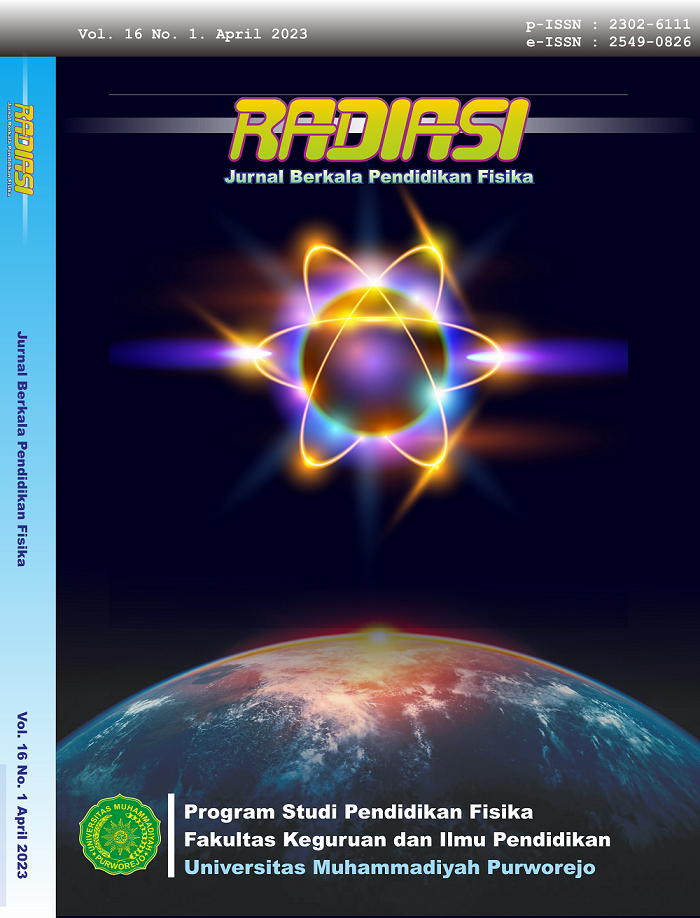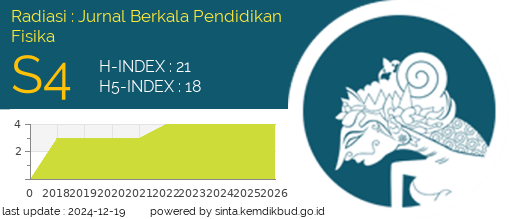Project 2-D Motion Simulation Based on Matlab Graphical User Interface in Physics Learning
Abstract
Learning physics requires students to master the basic concepts of physics. Not infrequently, the physics concept is abstract, so it isn't easy to be perceived by students. However, abstract concepts in physics learning can be overcome by visualizing physics concepts packaged in computer software-based application programs in the form of computer simulations. This study aims to develop a 2-D motion simulation program based on the Matlab GUI. This study uses the Research & Development method. The development of this application program is carried out through 4 stages called 4-D: Define, Design, Develop, and Dissemination. The subjects in this study were 20 students of class XI MAS Nurul Jannah Ampenan. From the results of the study, it can be concluded that the quality of the product that has been developed is very feasible, with a percentage of 89,09% based on the assessment of material experts, 93,33% by media experts in the appropriate category, the response of students in class XI MAS Nurul Jannah Ampenan on the motion simulation application program 2- D-based GUI Matlab with a percentage of 88,20% with an excellent category, and an increase in understanding of physics concepts on the subject of 2-D motion; projectile motion after students use the 2-D motion simulation application program is in the medium category, seen from the class average gain value of 0.62. Therefore, the application program that has been developed has met the eligibility criteria and can be used in physics learning.
Downloads
References
M. Abdullah, Fisika Dasar I. Bandung: ITB Press, 2016.
A. Swandi, S. Rahmadhanningsih, S. Viridi, N. Nurhayati, R. A. Putri, dan A. Suryadi, “Simulasi Gerak Translasi Dan Gerak Melingkar Menggunakan Vba Macro Excel Melalui Project Based Learning (Pbl),” JPF J. Pendidik. Fis. Univ. Islam Negeri Alauddin Makassar, vol. 9, no. 1, hlm. 33, 2021, doi: 10.24252/jpf.v9i1.20519.
P. Palloan, B. Amin, dan H. Herman, “Pengembangan Program Simulasi Berbasis Komputer Dalam Perkuliahan Gelombang Dan Optika Untuk Meningkatkan Pemahaman,” J. Sains Dan Pendidik. Fis., hlm. 237–248, 2015.
C. Sarabando, J. P. Cravino, dan A. A. Soares, “Contribution of a Computer Simulation to Students’ Learning of the Physics Concepts of Weight and Mass,” Procedia Technol., 2014, doi: 10.1016/j.protcy.2014.02.015.
G. A. Away, The Shortcut Of Matlab Programming. Bandung: Informatika Bandung, 2014.
G. Liu dan Y. Gao, “The application of MATLAB in communication theory,” dalam Procedia Engineering, doi: 10.1016/j.proeng.2011.12.715. 2012.
S. K. Sen dan G. A. Shaykhian, “MatLab tutorial for scientific and engineering computations. International Federation of Nonlinear Analysts (IFNA); 2008 World Congress of Nonlinear Analysts (WCNA),” Nonlinear Anal. Theory Methods Appl., 2009, doi: 10.1016/j.na.2009.01.069.
A. Adi Sucipto dan B. Suprianto, “Pengembangan Media Pembelajaran Menggunakan Gui Matlab Pada Pokok Bahasan Modulasi Analog Dan Digital Kelas Xi Tav Smk Negeri 1 Sidoarjo,” J. Pendidik. Tek. Elektro, 2016.
A. Sugiharto, Pemrograman GUI dengan Matlab. Semarang: Andi, 2016.
R. Rustan, “Pemodelan Gerak 2 Dimensi Berbasis GUI Matlab dengan Ketinggian Awal Tertentu,” Radiasi J. Berk. Pendidik. Fis., doi: 10.37729/radiasi.v14i2.1288. 2021.
J. Rajagukguk dan C. Sarumaha, “Pemodelan Dan Analisis Gerak Parabola Dua Dimensi Dengan Menggunakan Aplikasi Gui Matlab,” J. Saintika, 2017.
E. A. S. Dela Mar’atul Kamilah, Mirda Prisma Wijayanto, Mulyanto, “Simulasi Gerak Parabola 3-Dimensi Menggunakan Matlab Graphical User Interface,” dalam Seminar Kontribusi Fisika, 2019.
R. Yosua, A. Fauzan, K. Kistiani, dan I. A. D. Astuti, “Aplikasi KALFIS (Kalkulator Fisika) berbasis matlab untuk membantu analisis eksperimen fisika,” Navig. Phys. J. Phys. Educ., doi: 10.30998/npjpe.v1i2.201. 2020.
Sukmadinata, Metodelogi Penelitian. Bandung: PT. Remaja Rosidataria., 2016.
S. Thiagarajan, D. S. Semmel, dan M. I. Semmel, “Instructional Development for Training Teachers of Exceptional Children. Washinton DC: National Center for Improvement Educational System.,” Educ. Resour. Inf. Cent. ERIC, 1974.
Sugiyono, “Metode Penelitian Pendidikan pendekatan Kuantitatif, Kualitatif dan R&D.,” dalam METODE PENELITIAN ILMIAH, 2014.
S. Sugiyono, Qualitative Quantitative Research Methods and R & D. Bandung: Alfabeta, 2013.
S. Rahayu, “Model simulasi dalam mata kuliah strategi pembelajaran fisika,” J. Pendidik. Fis. Dan Teknol., vol. 1, no. 2, hlm. 118–122, 2015.
D. R. Rizaldi, A. W. Jufri, dan J. Jamaluddin, “PhET: Simulasi interaktif dalam proses pembelajaran fisika,” J. Ilm. Profesi Pendidik., vol. 5, no. 1, hlm. 10–14, 2020.
H. Putranta dan I. Wilujeng, “Physics learning by PhET simulation-assisted using problem based learning (PBL) model to improve students’ critical thinking skills in work and energy chapters in MAN 3 Sleman,” dipresentasikan pada Asia-Pacific Forum on Science Learning and Teaching, The Education University of Hong Kong, Department of Science and …, 2019, hlm. 1–44.
Copyright (c) 2023 Zulkarnain Zulkarnain, Islahudin Islahudin, M. Isnaini, Linda Sekar Utami, Khairil Anwar, Ni Wayan Sri Darmayanti

This work is licensed under a Creative Commons Attribution-NonCommercial 4.0 International License.




